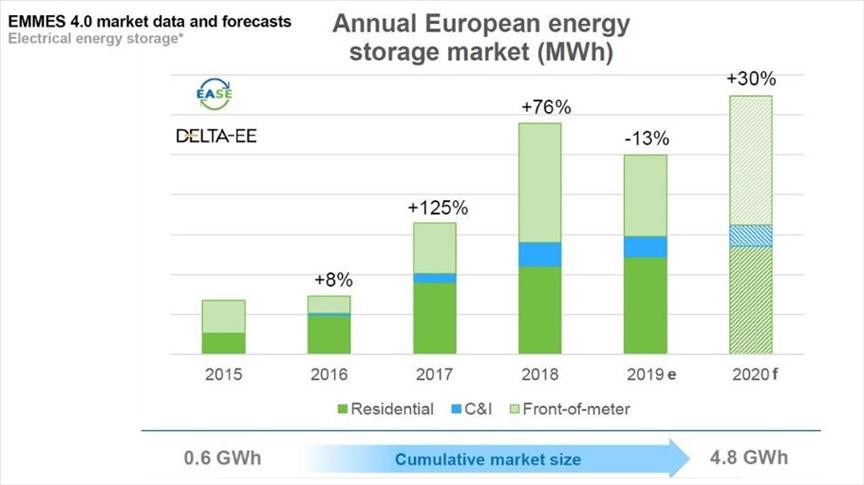The European energy storage market saw a significant year-on-year slow-down in 2019 with a growth of 1 gigawatt-hour (GWh), according to a new report by the European Association for Storage of Energy (EASE) on Monday.
The fourth edition of the European Market Monitor on Energy Storage (EMMES), launched by EASE, together with Europe’s energy research and consulting company Delta-EE, shows that 2018 was a bumper year for Europe’s energy storage with a 76% annual growth rate. However, this has fallen off by 13% in 2019.
According to the report, front-of-meter installations slowed dramatically in 2019, while residential behind-the-meter capacity was the fastest-growing market segment.
A behind-the-meter system provides power that can be used on-site without passing through a meter, while a front-of-meter system provides power to off-site locations. The power provided by a front-of-meter system must pass through an electric meter before reaching an end-user.
EMMES also highlighted that 2018 saw a particularly rapid increase in front-of-the-meter projects, partly driven by Enhanced Frequency Response (EFR) tenders, bringing significant levels of storage to the market.
This resulted in higher competition, lower prices and revenue streams partly explaining the slowdown in the rate of growth in 2019.
According to EASE Secretary General Patrick Clerens, more support is needed to turn this growth around.
“The message is clear: even if energy storage is a key enabler of the energy transition and clearly seen as a major tool to achieve the emissions targets linked to the Paris agreement, more support is needed,' Clerens was quoted as saying.
He stressed that the Clean Energy for All Europeans Package (CEP) is an important step in this process by clearly defining this concept to allow energy storage to reach its full potential fast.
EASE noted that the report provides an analysis of the implementation of the CEP in Europe, which aims to create a stronger regulatory framework for energy storage across Europe.
The report argued that regulatory changes would occur as consumers in both the residential and commercial and industrial segments show rising interest in storage as technologies costs fall and feed-in-tariffs are phased out.
Robin Adey-Johnson, energy storage and flexibility analyst at Delta-EE added that storage remains a young market in which the regulatory landscape is trying to catch up.
'So, year-on-year fluctuations in market growth are not unexpected. But we see strong underlying drivers and we expect further market expansion in the early 2020s as regulation stabilizes and revenue streams mature,” Adey-Johnson said.
By Ebru Sengul Cevrioglu
Anadolu Agency
energy@aa.com.tr


